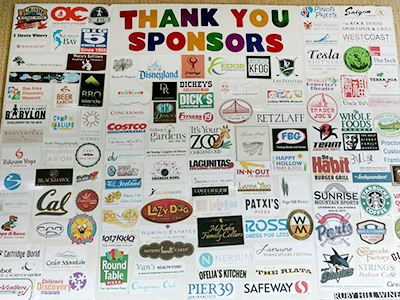How To Get Sponsorships for Your School Events

Company event sponsors can reduce your costs and help businesses raise their profile in the school community.
If your parent group is like most, a major consideration for most events and activities is how you’re going to pay for them. Finding business sponsors to help offset costs can mean, for example, being able to offer cool extras at your carnival or, in some cases, being able to hold the event at all.
The good news is, lots of businesses know that it’s a smart idea to sponsor school events by donating money to a PTO or PTA. Not only does it help their business gain exposure; it also puts them forward as a community partner that wants to be part of helping children and schools, among other benefits.
If you want to work on getting sponsorships from local businesses, try these tips from leaders who’ve had success.
Join the PTO Today community (it's free) for access to resources, giveaways and more
Get Organized
As with other parent group business, a first step is to decide who should be in charge of your sponsorship outreach. This does not need to be (and probably shouldn’t be) the overall event coordinator; it can be anyone with good organization skills who isn’t afraid to put themselves out there. Depending on the scope of the work, a small team often works well—but even in that case, you want a single individual to be the point person.
A next step would be to decide on a system for staying organized. A paper tracking system could be as simple as keeping copies of sponsorship request letters in a binder and writing the results right on the paper. But if you’re working with a team, a shared spreadsheet is an easy way for team members to enter activities like letters sent, personal visits, or phone calls made and to record results. These records are important for both monitoring what’s in process and planning for future years.
Leah Kletnieks, PTO president at Jackson Avenue Elementary in Livermore, Calif., says that when she was looking for donors for her school’s auction, she was lucky that previous organizers had created a detailed spreadsheet. She added each buiness she contacted for donations or sponsorship; it included some 300 businesses’ names and details.
Look for Event Sponsorship Leads
Work your network. Before you start pounding the proverbial pavement, think and ask about your school community. Do you know parents who are business owners? Or those who work within the community or for a company that might be willing to sponsor your event? Either way, let parents know you’re looking for event sponsors. There could be a good number of leads right with your community.
Think local. At the same time, put together a list of local businesses. Don’t be shy—you won’t know which businesses are willing to provide an event sponsorship unless you ask. It could be that the owner of the town’s busiest grocery store went to the school and wants to give back or that he has kids there now. It takes some work, but casting a wide net in your area is critical.
At Highcliff Elementary in Pittsburgh, Pa., the PTO fundraising committee specifically reaches out to local businesses within the school district because there’s a better chance those business owners will know someone personally—maybe even a family member—who will benefit from the donation.
Expand your reach to bigger businesses in the surrounding area, too. “We basically hit up every business in our city and some of the bigger businesses in our neighboring cities. Also, if there are any local sports teams, radio stations, amusement parks, zoos, etc., they usually donate,” Kletnieks says.
Start early. Kletnieks recommends starting outreach to businesses five to six months before the event—some larger businesses actually require a lead time of 90 days or more to respond. But she takes the early recommendation even further: Many businesses have a donation budget that renews at the beginning of the year, making January the best time to approach them.
Ask Businesses for Support
In the old days, it would have been an absolute must to mail or hand-deliver a letter asking for an event sponsorship. These days, it’s still good (and makes you look good) to get personal when possible; a letter or email is also useful for keeping track of what requests were made that year and later serve as a record of which requests were successful. But increasingly, businesses require organizations to fill out online donation request forms, so it’s not always possible to be personal.
For local requests, you can improve your chances by calling each business first and asking to speak to the manager. If the manager says they do accept requests for sponsorships, let them know you’re mailing or emailing the letter or delivering it in person. Then personalize your letter for that business and print it on school or PTO letterhead. Include all the necessary contact information in case the manager has questions.
In your requests, include:
-
Estimated event attendance
-
How money raised at the event will be used, if applicable
-
How the company’s donation will be recognized
-
Event sponsorship levels and sponsorship commitment deadline
-
Your group’s 501(c)(3) status and tax ID number, if applicable
This sample sponsor request letter can help you get started.
(Note: When you’re a 501(c)(3) organization, contributions to your group are tax-deductible for the donor—an important point to many, particularly some larger businesses. Some businesses won’t even accept requests from groups that aren’t federally recognized tax-exempt organizations. Learn more about tax-exemption for PTOs.)
You might need to follow up on emails or letters with a phone call or visit. This is a key area where it pays off to pick the right point person. This type of outreach takes time and patience. And then more time.
What Event Sponsors Get in Return
Promoting their brand and being seen as community partners are good incentives for businesses to sponsor school events, but many groups find that interest increases when they offer different event sponsorship “levels.” What’s offered at each level of sponsorship varies, but common incentives include printing a company name on event T-shirts, displaying table tents or placards with a business’s name, mentioning the company on social media and on the school’s electronic sign, and including a business ad in a yearbook or directory.
Here’s a typical example of sponsorship levels for a fun run, provided by the Jackson Avenue PTO:
Name ad ($250): Company name on back of shirt, and one shirt
Regular ad ($500): Medium logo ad on back of shirt, one shirt, and logo on PTO website and Facebook page
Premium ad ($750): Large logo ad on top back of shirt, one shirt, logo on PTO website and Facebook page, and name announced at fun run and listed on other marketing materials
Sleeve ad ($1,000): Logo ad on sleeve of shirt, one shirt, logo on PTO website and Facebook page, name announced at fun run and listed on other marketing materials, and company signage displayed at fun run
Regardless of whether you take the leveled sponsorship approach, it’s important to recognize the businesses that participate. You can do this in any number of ways—if the event has a DJ, for example, you could have him mention the sponsor. Or take a fun and creative approach, like this logo board that Kletnieks created for her group’s auction:

“With the logos, people can quickly look at most images and automatically know the business without having to read all the names,” Kletnieks says. “In addition to this, we also send a flyer home with all our students advertising the event, and it lists the names of all the sponsors and we post it on our Facebook group.”
After the Event
Shortly after the event, thank sponsors with a card, letter, or email. If possible, share details like how many people attended and how much money was raised. In addition, if your organization has 501(c)(3) status, sponsors will most likely expect a donation acknowledgement receipt or letter for tax purposes.
Some groups send sponsors certificates that they can display in their place of business. For example, “Company X is a proud sponsor of the Smith Elementary PTO.” Others have students create thank-you posters that businesses can display.
Before taking the break you deserve, check that your files are up to date and ready to pass on to the next volunteer who takes on the task.






















